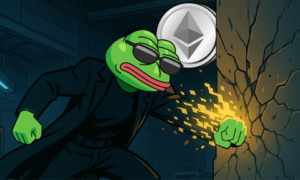Are you ready to take a deep dive into the fascinating world of NFT tokens? While Bitcoin has captured headlines for its role in revolutionizing finance, non-fungible tokens (NFTs) are shaking up the digital landscape in their own unique way. From stunning artwork to virtual real estate and even memorable moments from your favorite sports games, NFTs offer a whole new dimension of ownership and possibilities. In this blog post, we will explore the extraordinary properties and revolutionary applications of these blockchain-based assets that are taking the world by storm.
Introduction to NFT Tokens
NFT (Non-Fungible Tokens) is a relatively new concept in the world of cryptocurrency and blockchain technology. While most people are familiar with popular cryptocurrencies like Bitcoin and Ethereum, NFTs have gained significant attention due to their unique properties and applications.
But what exactly are NFT tokens, and how do they differ from other digital assets? In this section, we will dive into the fundamentals of NFTs, including their definition, characteristics, and uses.
What are NFT tokens?
NFT (Non-Fungible Token) is a type of cryptocurrency that has been making waves in the digital world. While most people are familiar with popular cryptocurrencies like Bitcoin, NFTs have gained attention for their unique properties and applications. In this section, we will explore what NFT tokens are, how they work, and their potential uses.
To understand NFT tokens, it’s essential to first grasp the concept of fungibility. Fungibility refers to the interchangeability of an asset or currency with another of equal value. For example, one dollar bill can be exchanged for another without any difference in value. This makes traditional currencies like cash or gold fungible assets.
On the other hand, non-fungible assets possess unique characteristics that make them irreplaceable or non-interchangeable with other items. For instance, each piece of artwork is unique and cannot be replicated exactly. This uniqueness gives it a higher value than a mass-produced item.
NFT tokens are digital assets built on blockchain technology that represent ownership of a particular item or asset in the virtual space. Unlike traditional cryptocurrencies, which are interchangeable and hold the same value as other units of their kind, each NFT token represents something entirely unique.
How do NFTs differ from traditional cryptocurrencies like Bitcoin?
NFTs, or non-fungible tokens, have recently gained a lot of attention in the world of cryptocurrency and blockchain technology. While Bitcoin and other traditional cryptocurrencies have dominated the market for several years now, NFTs offer a unique set of properties and applications that differentiate them from their more well-known counterparts.
1. Fungibility vs. non-fungibility
The main difference between NFTs and traditional cryptocurrencies like Bitcoin lies in their fungibility, or lack thereof. Fungibility refers to the interchangeability of each unit within a currency, meaning one unit can be exchanged for another identical unit without any difference in value. This is why traditional cryptocurrencies are known as “fungible” assets: each bitcoin holds the same value as another bitcoin.
On the other hand, NFTs are considered “non-fungible” assets because each token holds its own unique value and cannot be interchanged with another token. This is due to the fact that NFTs are designed on an individual basis, with each token containing specific information that makes it distinct from all others.
2. Ownership and scarcity
Another key difference between NFTs and traditional cryptocurrencies is ownership and scarcity. While anyone can purchase bitcoins or other cryptocurrencies on an exchange platform, ownership of an NFT requires a bit more effort. Each NFT token is linked to a specific digital asset, such as artwork or collectibles, creating a sense of scarcity since there is only one original version of that particular token.
This ownership and scarcity also add value to NFTs, as they represent a one-of-a-kind asset that cannot be replicated or duplicated. This is in contrast to traditional cryptocurrencies, where the value is determined by market demand and supply.
3. Use Cases
NFTs and traditional cryptocurrencies also differ in their use cases. Traditional cryptocurrencies like Bitcoin are primarily used as a medium of exchange and store of value, while NFTs have a wider range of potential applications.
One popular application for NFTs is in the world of digital art, where artists can create and sell unique digital pieces that can be verified on the blockchain as original and authentic. They can also be used for tokenizing physical assets such as real estate or collectibles, creating a more efficient way to track ownership and transfer ownership rights.
4. Blockchain Technology
Both NFTs and traditional cryptocurrencies utilize blockchain technology, but they do so in different ways. Traditional cryptocurrencies use blockchain technology to record transactions on a decentralized ledger, allowing for secure peer-to-peer transactions without the need for intermediaries.
NFTs use blockchain technology to create an immutable record of ownership and authenticity for digital assets, making it difficult for them to be counterfeited or tampered with.
Unique properties of NFT tokens
NFTs, or non-fungible tokens, have exploded onto the digital art scene in recent years, captivating both artists and collectors alike. But what exactly are NFTs, and what makes them so special? In this section, we will dive into the unique properties of NFT tokens and explore their various applications.
1. Scarcity
One of the defining features of NFTs is their scarcity. Unlike traditional cryptocurrencies like Bitcoin, which are fungible (meaning each unit is interchangeable), each NFT token is one-of-a-kind and cannot be replicated or duplicated. This scarcity adds value to NFTs as they become rare collectibles in the digital world.
2. Proof of ownership and authenticity
NFTs utilize blockchain technology to provide a transparent record of ownership and provenance for digital assets. Each token contains a unique identification code that verifies its authenticity, making it impossible to forge or counterfeit an NFT. This feature is especially important for digital artists who may face issues with copyright infringement.
3. Immutable ownership rights
Once an artist creates an NFT, they can embed specific terms into the token’s code that allow them to receive royalties every time their work is sold on a secondary market. Additionally, because these terms are embedded in blockchain technology, they cannot be altered or removed by anyone else other than the original creator.
Real-world applications of NFT tokens
NFTs, or non-fungible tokens, have gained significant attention and popularity in recent years due to their unique properties that allow for ownership of digital assets. While most people associate NFTs with the world of art and collectibles, there are actually a wide range of real-world applications for these tokens. In this section, we will dive into some of the most notable use cases for NFTs beyond the realm of cryptocurrency.
1. Digital Art and Collectibles:
One of the most well-known applications of NFTs is in the world of digital art and collectibles. NFTs allow artists to create unique digital artworks that can be bought, sold, and traded as one-of-a-kind items on blockchain platforms. This has opened up a whole new market for artists to showcase and monetize their work without needing intermediaries such as galleries or auction houses.
Moreover, NFT technology also allows for proof of ownership and authenticity for these digital assets. With each token being uniquely coded on the blockchain, it becomes impossible to duplicate or counterfeit an NFT artwork, giving buyers peace of mind when investing in these pieces.
2. Gaming:
Another exciting application for NFTs is in the gaming industry. As more games move towards a digital format, players are investing large sums in virtual items such as skins, weapons, or characters within these games. These items can now be tokenized using NFT technology, giving players true ownership over their virtual possessions.
Current market trends and future potential of NFTs
While Bitcoin may have initially captured the attention of many cryptocurrency investors, NFTs are now making waves in the digital asset space with their unique properties and diverse range of applications.
NFTs are essentially digital assets that represent ownership of a particular item or asset, such as artwork, music, videos, or even virtual real estate. Each token is unique and cannot be exchanged for an equal value, like traditional cryptocurrencies. This makes them ideal for representing one-of-a-kind items in a secure and transparent way.
One major trend that we are currently seeing in the NFT market is the increasing interest from mainstream industries such as art, sports, and gaming. In March 2021 alone, over $200 million worth of NFTs were sold on various platforms—a significant increase from previous months. This surge can be attributed to more artists and creators recognizing the potential to monetize their work through NFTs, as well as big brands teaming up with popular platforms to release limited-edition collectibles.
Conclusion
NFTs have taken the digital world by storm, revolutionizing the way we think about ownership and value in the online space. As we have explored in this article, NFTs are much more than just a digital form of currency like Bitcoin. They possess unique properties that make them stand out in the world of cryptocurrency.


































